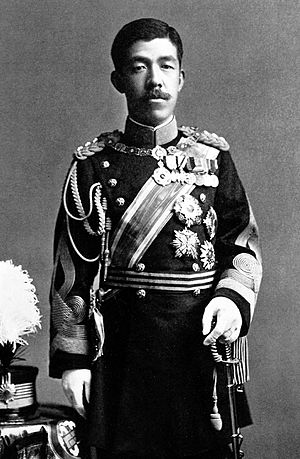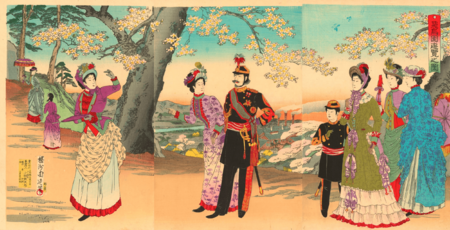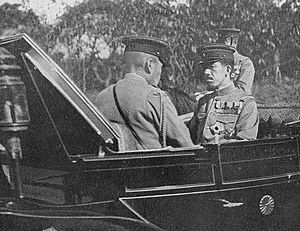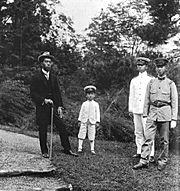Emperor Taishō facts for kids
Quick facts for kids Emperor Taishō大正天皇 |
|||||||||
|---|---|---|---|---|---|---|---|---|---|

Formal portrait, 1912
|
|||||||||
| Emperor of Japan | |||||||||
| Reign | 30 July 1912 – 25 December 1926 | ||||||||
| Enthronement | 10 November 1915 | ||||||||
| Predecessor | Meiji | ||||||||
| Successor | Shōwa | ||||||||
| Regent | Hirohito (1921–1926) | ||||||||
| Prime Ministers |
See list
Saionji Kinmochi
Katsura Tarō Ōkuma Shigenobu Terauchi Masatake Hara Takashi Uchida Kōsai Yamamoto Gonbee Yamagata Aritomo Kiyoura Keigo Katō Takaaki Wakatsuki Reijirō |
||||||||
| Born | Yoshihito (嘉仁) 31 August 1879 Tōgū Palace, Akasaka, Tokyo, Empire of Japan |
||||||||
| Died | 25 December 1926 (aged 47) Imperial Villa, Hayama, Kanagawa, Empire of Japan |
||||||||
| Burial | 8 February 1927 Musashi Imperial Graveyard |
||||||||
| Spouse |
Sadako Kujō
(m. 1900) |
||||||||
| Issue |
|
||||||||
|
|||||||||
| House | Imperial House of Japan | ||||||||
| Father | Emperor Meiji | ||||||||
| Mother | Yanagiwara Naruko | ||||||||
| Religion | Shinto | ||||||||
| Signature | |||||||||
Emperor Taishō (大正天皇, Taishō-tennō, 31 August 1879 – 25 December 1926) was the 123rd Emperor of Japan. He ruled the Empire of Japan from July 30, 1912, until his death in 1926.
His personal name was Yoshihito. In Japan, when an emperor is ruling, people simply call him "the Emperor". After he dies, he gets a special name called a posthumous name. This name is usually the same as the era he ruled under. Since Emperor Yoshihito ruled during the Taishō era, he is known as "Emperor Taishō".
Contents
Early Life of Emperor Taishō
Prince Yoshihito was born in Akasaka, Tokyo, on August 31, 1879. His parents were Emperor Meiji and a lady named Yanagiwara Naruko. At that time, it was common for the Emperor's official wife, Empress Shōken, to be seen as the mother of his children.
Yoshihito was given the name Yoshihito Shinnō and the title Haru-no-miya. Sadly, his two older brothers had died very young. Yoshihito himself was born sickly and caught a serious brain infection (cerebral meningitis) soon after he was born.
Childhood and Care
As was the custom, Prince Yoshihito was cared for by his great-grandfather, Marquess Nakayama Tadayasu. He lived in Nakayama's home until he was seven years old. Interestingly, Nakayama had also raised Emperor Meiji, Yoshihito's father, when he was a child.
In March 1885, Prince Yoshihito moved to the Aoyama Detached Palace. Here, he had tutors who taught him reading, writing, math, and good manners in the mornings. In the afternoons, he practiced sports. However, his health was often poor, and he had frequent fevers, which made learning slow.
From 1886, he studied with 15-20 other selected classmates. These were children from important noble families. They attended a special school called the Gogakumonsho inside the Aoyama Palace.
On August 31, 1887, Yoshihito was officially named the heir apparent, meaning he was next in line to become emperor. His formal ceremony as crown prince happened on November 3, 1888. When he was the crown prince, people often called him Tōgu (東宮), which means 'Eastern Palace'. This was a special way to refer to the heir to the throne, a tradition from ancient China.

Prince Yoshihito's Education
Because of his health issues, Prince Yoshihito had a special education officer, Takehiko Yumoto, who taught him at the Tōgū Palace starting in 1886. He spent a lot of his youth at imperial homes by the sea in Hayama and Numazu.
The prince was good at some things, like horse riding. But he struggled with subjects that needed deep thinking. He left the Gakushuin school before finishing middle school in 1894. However, he was good at languages. He continued to learn French, Chinese, and history from private tutors at the Akasaka Palace. Emperor Meiji asked Prince Takehito to look after Prince Yoshihito, and they became good friends.
In 1898, a powerful leader named Itō Hirobumi encouraged the prince to attend meetings of the Japanese House of Peers. This was a way for him to learn about Japan's politics and military. That same year, he met foreign diplomats for the first time. He was able to shake hands and talk politely with them. He really liked Western culture and often used French words, which sometimes annoyed his father, Emperor Meiji.
Prince Yoshihito also traveled around Japan. In October 1898, he visited Kobe, Hiroshima, and Etajima, seeing places important to the Imperial Japanese Navy. In 1899, he toured Kyūshū, visiting government offices, schools, and factories like Yawata Iron and Steel and Mitsubishi shipyards.
Marriage and Family
On May 10, 1900, Crown Prince Yoshihito married 15-year-old Kujō Sadako. She was chosen carefully by Emperor Meiji because she was smart, spoke well, and had a kind and dignified personality. She was meant to help Prince Yoshihito in areas where he was not as strong. The Akasaka Palace was built between 1899 and 1909 as their official home.
The Prince and Princess had four sons:
- Hirohito, Emperor Shōwa
- Yasuhito, Prince Chichibu
- Nobuhito, Prince Takamatsu
- Takahito, Prince Mikasa
In 1902, Yoshihito continued his travels to learn about Japan's customs and geography. He visited central Honshū, including the famous Buddhist temple of Zenkō-ji in Nagano. As tensions grew between Japan and Russia, Yoshihito was promoted in 1903 to the rank of colonel in the Imperial Japanese Army and captain in the Imperial Japanese Navy. His military duties were mostly for show, but he did visit military bases in several prefectures that year.
In October 1907, the Crown Prince visited Korea. This was the first time an heir to the Japanese throne had ever left Japan. During this trip, he started learning the Korean language, though he never became fluent.
Emperor Taishō's Reign

On July 30, 1912, after his father Emperor Meiji passed away, Prince Yoshihito became the new emperor. He suffered from various health problems, including neurological issues. Because of this, he was kept away from public view as much as possible.
One famous story is from the 1913 opening of the Imperial Diet of Japan. This was one of the few times he was seen in public. He is said to have rolled up his speech and looked through it like a spyglass. Some people thought this showed he was not mentally well. However, others who knew him believed he might have been checking if the speech was rolled correctly, as he also had trouble with his hands.
Because of his health and unique behaviors, people started to talk more openly about the emperor. He became less interested in daily political matters as his condition worsened. Powerful groups like the genrō (elder statesmen) and imperial officials began to have more influence over his decisions.
During his reign, Japan saw the rise of a two-party political system, especially after World War I. This period is sometimes called "Taishō Democracy". It meant that political power started to shift more towards the Imperial Diet of Japan and democratic parties.
After 1918, the emperor could no longer attend military events or graduation ceremonies. He also stopped performing traditional Shinto rituals or attending the opening of the Diet. By 1919, he stopped all official duties. His eldest son, Crown Prince Hirohito, was named prince regent on November 25, 1921. This meant Hirohito would rule in his father's place.
The emperor's quiet life was not affected by the Spanish Flu Pandemic of 1918 or the terrible Great Kantō Earthquake of 1923. Luckily, he had moved to his villa in Nikko by imperial train the week before the earthquake. His son, Crown Prince Hirohito, stayed at the Imperial Palace and was at the center of the disaster. Carrier pigeons were used to send messages and keep the Emperor updated on the damage.
Death of Emperor Taishō
In early December 1926, it was announced that the emperor had pneumonia. He passed away from a heart attack very early in the morning on December 25, 1926. He died at the Hayama Imperial Villa in Hayama, Kanagawa, which is on Sagami Bay south of Tokyo. He was 47 years old. His eldest son, Hirohito, became the next emperor.
His funeral was held at night, from February 7 to February 8, 1927. It was a long procession, about 4 miles (6.4 km) long. Twenty thousand mourners followed sacred bulls and an ox-drawn cart carrying the emperor's coffin. The path was lit by wood fires in iron lanterns.
Emperor Taishō's coffin was then taken to his burial place in the western suburbs of Tokyo. He is known as the first "Tokyo Emperor" because he was the first to live his entire life in or near Tokyo. His father, Emperor Meiji, was born in Kyoto, and his grave is near Kyoto. But Emperor Taishō's grave is in Tokyo, at the Musashi Imperial Graveyard in Hachiōji. His wife and his son, Emperor Shōwa, are also buried near him.
Images for kids
-
Emperor Taishō wearing the robes of the Order of the Garter
Emperor Taishō (大正天皇, Taishō-tennō, 31 August 1879 – 25 December 1926) was the 123rd Emperor of Japan, according to the traditional order of succession, and the second ruler of the Empire of Japan from 30 July 1912 until his death in 1926.
The Emperor's personal name was Yoshihito (嘉仁). According to Japanese custom, while reigning the Emperor is simply called "the Emperor". After death, he is known by a posthumous name, which is the name of the era coinciding with his reign. Having ruled during the Taishō era, he is known as the "Emperor Taishō".
Early life
Prince Yoshihito was born at the Tōgū Palace in Akasaka, Tokyo to Emperor Meiji and Yanagiwara Naruko, a concubine with the official title of gon-no-tenji (imperial concubine). As was common practice at the time, Emperor Meiji's consort, Empress Shōken, was officially regarded as his mother. He received the personal name of Yoshihito Shinnō and the title Haru-no-miya from the Emperor on 6 September 1879. His two older siblings had died in infancy, and he too was born sickly.
Prince Yoshihito contracted cerebral meningitis within three weeks of his birth.
As was the practice at the time, Prince Yoshihito was entrusted to the care of his great-grandfather, Marquess Nakayama Tadayasu, in whose house he lived from infancy until the age of seven. Prince Nakayama had also raised his grandson, Emperor Meiji, as a child.
From March 1885, Prince Yoshihito moved to the Aoyama Detached Palace, where he was tutored in the mornings on reading, writing, arithmetic, and morals, and in the afternoons on sports, but progress was slow due to his poor health and frequent fevers. From 1886, he was taught together with 15–20 selected classmates from the ōke and higher ranking kazoku peerage at a special school, the Gogakumonsho, within the Aoyama Palace.
Yoshihito was officially declared heir on 31 August 1887, and had his formal investiture as crown prince on 3 November 1888. While crown prince, he was often referred to simply as Tōgu (東宮) (Or 'Eastern Palace', a metonymy for heir to the throne originated from China's Han dynasty).

Education and training
When Yoshihito became the age to enter elementary school in 1886, due to his health problems, Takehiko Yumoto was appointed as the special education officer to educate him within the Tōgū Palace. For this health reasons, he spent much of his youth at the Imperial villas at Hayama and Numazu, both of which are located at the sea. Although the prince showed skill in some areas, such as horse riding, he proved to be poor in areas requiring higher-level thought. He was finally withdrawn from Gakushuin before finishing the middle school course in 1894. However, he did appear to have an aptitude for languages and continued to receive extensive tutoring in French, Chinese, and history from private tutors at the Akasaka Palace; Emperor Meiji gave Prince Takehito responsibility for taking care of Prince Yoshihito, and the two princes became friends.
From 1898, largely at the insistence of Itō Hirobumi, the Prince began to attend sessions of the House of Peers of the Diet of Japan as a way of learning about the political and military concerns of the country. In the same year, he gave his first official receptions to foreign diplomats, with whom he was able to shake hands and converse graciously. His infatuation with western culture and tendency to sprinkle French words into his conversations was a source of irritation for Emperor Meiji.
In October 1898, the Prince also traveled from the Numazu Imperial Villa to Kobe, Hiroshima, and Etajima, visiting sites connected with the Imperial Japanese Navy. He made another tour in 1899 to Kyūshū, visiting government offices, schools and factories (such as Yawata Iron and Steel in Fukuoka and the Mitsubishi shipyards in Nagasaki).
Marriage
On 10 May 1900, Crown Prince Yoshihito married the then 15-year-old Kujō Sadako, daughter of Prince Kujō Michitaka, the head of the five senior branches of the Fujiwara clan. She had been carefully selected by Emperor Meiji for her intelligence, articulation, and pleasant disposition and dignity – to complement Prince Yoshihito in the areas where he was lacking. The Akasaka Palace was constructed from 1899 to 1909 in a lavish European rococo style, to serve as the Crown Prince's official residence. The Prince and Princess had the following children: Hirohito, Yasuhito, Nobuhito, Takahito
In 1902, Yoshihito continued his tours to observe the customs and geography of Japan, this time of central Honshū, where he visited the noted Buddhist temple of Zenkō-ji in Nagano. With tensions rising between Japan and Russia, Yoshihito was promoted in 1903 to the rank of colonel in the Imperial Japanese Army and captain in the Imperial Japanese Navy. His military duties were only ceremonial, but he traveled to inspect military facilities in Wakayama, Ehime, Kagawa and Okayama that year.
In October 1907, the Crown Prince toured Korea, accompanied by Admiral Tōgō Heihachirō, General Katsura Tarō, and Prince Arisugawa Taruhito. It was the first time an heir apparent to the throne had ever left Japan. During this period, he began studying the Korean language, although he never became proficient at it.
Issue
Emperor Taishō and Empress Teimei had four sons and twelve grandchildren (five grandsons and seven granddaughters).
| Name | Birth | Death | Marriage | Their children | |
|---|---|---|---|---|---|
| Date | Spouse | ||||
| Hirohito, Emperor Shōwa (Hirohito, Prince Michi) |
29 April 1901 | 7 January 1989 | 26 January 1924 | Princess Nagako of Kuni |
|
| Yasuhito, Prince Chichibu (Yasuhito, Prince Atsu) |
25 June 1902 | 4 January 1953 | 28 September 1928 | Setsuko Matsudaira | none |
| Nobuhito, Prince Takamatsu (Nobuhito, Prince Teru) |
3 January 1905 | 3 February 1987 | 4 February 1930 | Kikuko Tokugawa | none |
| Takahito, Prince Mikasa (Takahito, Prince Sumi) |
2 December 1915 | 27 October 2016 | 22 October 1941 | Yuriko Takagi |
|
As emperor

On 30 July 1912, upon the death of his father, Emperor Meiji, Prince Yoshihito ascended the throne. The new emperor was kept out of view of the public as much as possible, having suffered from various neurological problems. At the 1913 opening of the Imperial Diet of Japan, one of the rare occasions he was seen in public, he is famously reported to have rolled his prepared speech into a cylinder and stared at the assembly through it, as if through a spyglass. Although rumors attributed this to poor mental condition, others, including those who knew him well, believed that he may have been checking to make sure the speech was rolled up properly, as his manual dexterity was also handicapped.
His lack of articulation and charisma, his disabilities and his eccentricities, led to an increase in incidents of lèse majesté. As his condition deteriorated, he had less and less interest in daily political affairs, and the ability of the genrō, Keeper of the Privy Seal, and Imperial Household Minister to manipulate his decisions came to be a matter of common knowledge. The two-party political system that had been developing in Japan since the turn of the century came of age after World War I, giving rise to the nickname for the period, "Taishō Democracy", prompting a shift in political power to the Imperial Diet of Japan and the democratic parties.
After 1918, the emperor no longer was able to attend Army or Navy maneuvers, appear at the graduation ceremonies of the military academies, perform the annual Shinto ritual ceremonies, or even attend the official opening of sessions of the Diet of Japan.
After 1919, he undertook no official duties, and Crown Prince Hirohito was named prince regent (sesshō) on 25 November 1921.
The emperor's reclusive life was unaffected by the Spanish Flu Pandemic of 1918 and Great Kantō Earthquake of 1923. Fortuitously, he had moved by imperial train to Tamozawa Imperial Villa at Nikko the week before the devastating calamity; but his son, Crown Prince Hirohito, remained at the Imperial Palace where he was at the heart of the event. Carrier pigeons kept the Emperor informed as information about the extent of the devastation became known.
Death
In early December 1926, it was announced that the emperor had pneumonia. He died of a heart attack at 1:25 a.m. in the early morning of December 25, 1926, at the Hayama Imperial Villa at Hayama, on Sagami Bay south of Tokyo (in Kanagawa Prefecture). He was 47 years old and succeeded by his eldest son, Hirohito, Emperor Shōwa.
The funeral was held at night (February 7 to February 8, 1927) and consisted of a 4-mile-long procession in which 20,000 mourners followed a herd of sacred bulls and an ox-drawn cart containing the imperial coffin. The funeral route was lit with wood fires in iron lanterns. The emperor's coffin was then transported to his mausoleum in the western suburbs of Tokyo.
Emperor Taishō has been called the first Tokyo Emperor because he was the first to live his entire life in or near Tokyo. His father was born and reared in Kyoto; and although he later lived and died in Tokyo, Emperor Meiji's mausoleum is located on the outskirts of Kyoto, near the tombs of his imperial forebears; but Emperor Taishō's grave is in Tokyo, in the Musashi Imperial Graveyard in Hachiōji. His wife and his son, the Emperor Shōwa, are buried near him.
See also
 In Spanish: Taishō Tennō para niños
In Spanish: Taishō Tennō para niños





